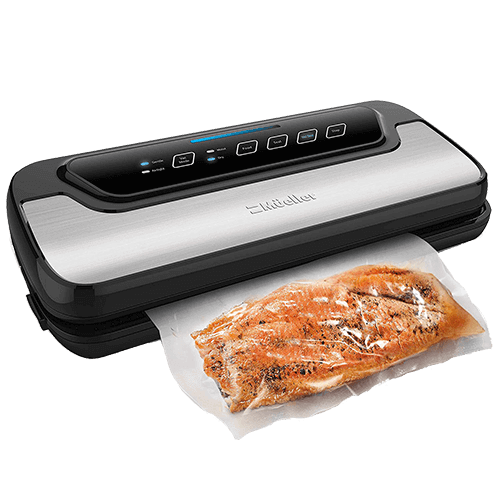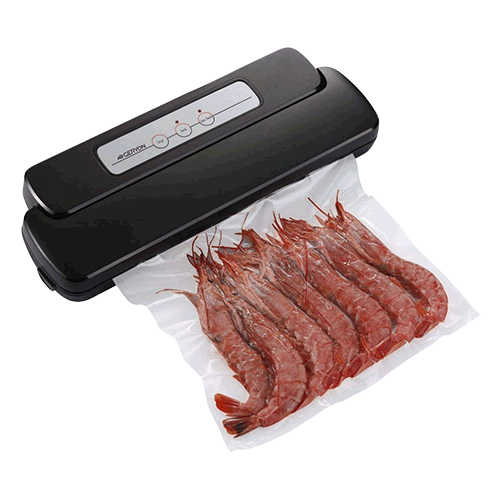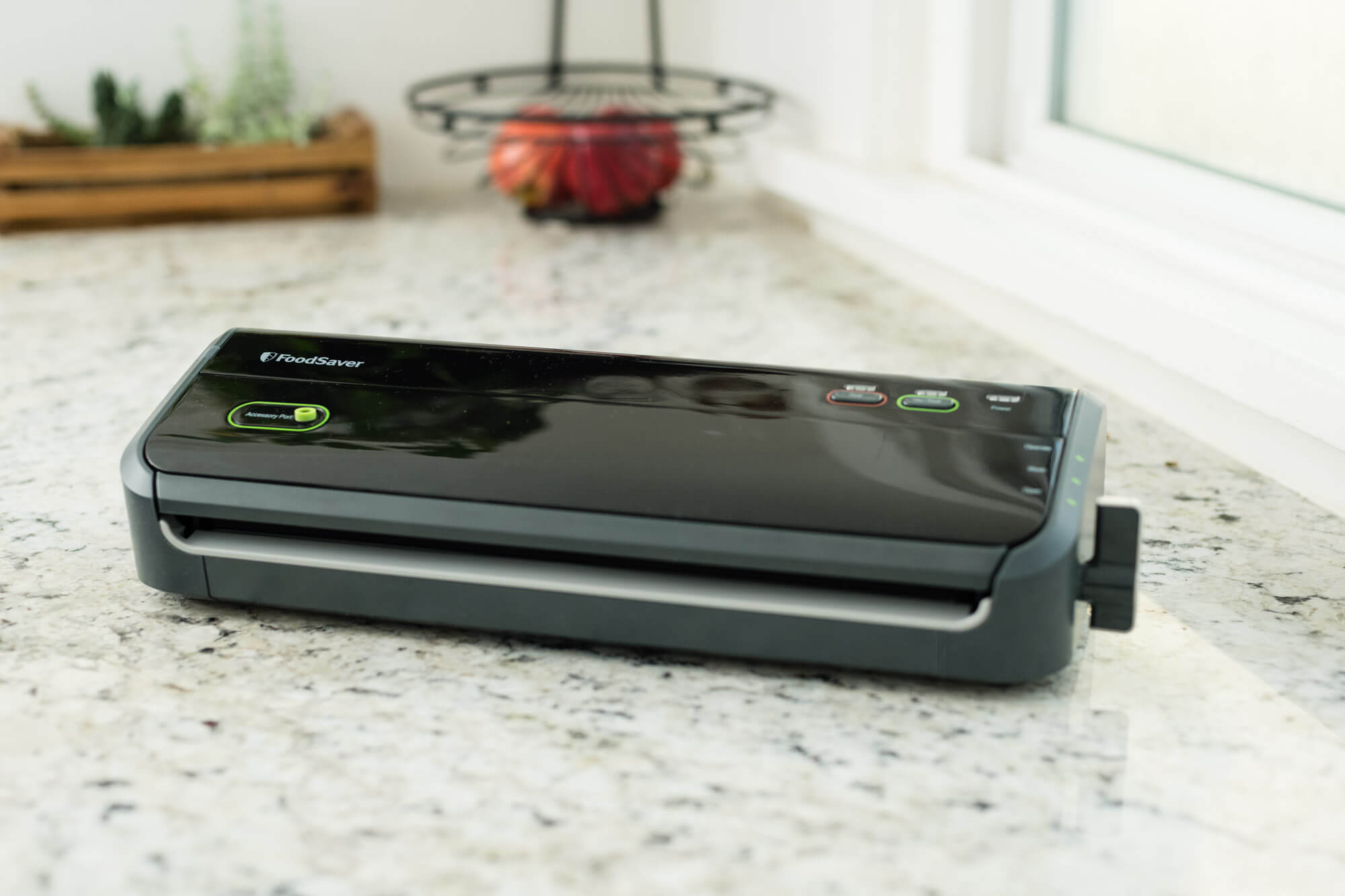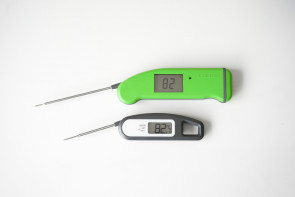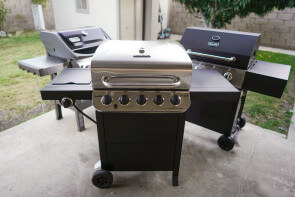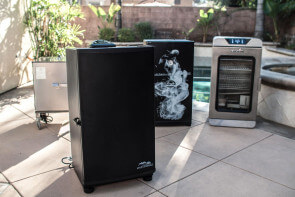
The Best Vacuum Sealers
We spent over 60 hours testing seven of the top vacuum sealers by sealing over a hundred bags with a variety of dry and wet foods and determined that the Mueller – MFFVS-01 is the best vacuum sealer. Ease of use and versatility made the Mueller the clear choice for efficiently and hygienically sealing food for storage, freezing, or sous-vide cooking. Our runner-up is the Geryon – E2800-C. It’s a little less reliable than the Mueller, but it’s still a good choice. If you want a built-in air pump to squeeze out every last bit of air, we also recommend the Foodsaver – v4840.
We spent over 60 hours testing seven of the top vacuum sealers by sealing over a hundred bags with a variety of dry and wet foods and determined that the Mueller – MFFVS-01 is the best vacuum sealer. Ease of use and versatility made the Mueller the clear choice for efficiently and hygienically sealing food for storage, freezing, or sous-vide cooking. Our runner-up is the Geryon – E2800-C. It’s a little less reliable than the Mueller, but it’s still a good choice. If you want a built-in air pump to squeeze out every last bit of air, we also recommend the Foodsaver – v4840.
Table of Contents
- How we selected products to test
- Compare the best vacuum sealers
- Best overall: Mueller – MFFVS-01
- Runner-up: Geryon – E2800-C
- Best with hand pump: Foodsaver – v4840
- Important features to consider
- How long does vacuum-sealed food last?
- How we tested
- Other finalists
- The bottom line
(Editors note: In early 2021, we learned that our former top pick, the Tinvoo – VS100S, appears to have been discontinued. For this 2021 update, we tested the Mueller – MFFVS-01 and our previous runner-up, Geryon – E2800C to see how they compared.)
How we selected products to test
With plenty of vacuum sealers available on Amazon, it was no easy feat to narrow down the list to choose the ones we would test. We started by talking to Chef Draper Donely, who helped us learn the essentials for food safety in vacuum-sealed foods. We also discussed with him the necessities of vacuum-sealing for sous-vide cooking.
While researching further in the subreddit /r/frugal, we learned vacuum sealers have a wide range of uses that place more importance on some features than others. For example, game hunters who spend several hours vacuum-sealing in one session need a machine that can stand up to repeated and heavy use but aren’t too concerned about how big the machines are.
This led us to look at some commercial-grade sealers such as the Weston Pro – 2300 and Cabela’s 12-inch commercial sealer. While these devices are well-loved by chefs and hunters alike, they also a hefty price tag. For the average kitchen, we scoured consumer reviews on Amazon, Reddit, and YouTube and reviewed reliability reports and warranties. No vacuum sealer scored a perfect review, but we were able to discern which ones you should consider purchasing.
Compare the best vacuum sealers
| Product | Price | Width | Warranty |
|---|---|---|---|
| 1. Mueller - MFFS-01 | $$ | 14 inches | 2 years |
| 2. Geryon - E2800-C | $ | 12 inches | 1 year |
| 3. FoodSaver - v4840 | $$$$$ | 11 inches | 5 years |
| 4. FoodSaver - FM2000 | $$ | 11 inches | 5 years |
| 5. NutriChef - PKVS18BK | $$ | 11 inches | N/A |
| 6. Nesco - VS-02 | $$ | 11 inches | 1 year |
| 7. Tinvoo - VS100S (Discontinued) | $$ | 11 inches | 1 year |
1. Mueller – MFFVS-01

For this 2021 update, we researched the latest models that had the highest consumer satisfaction, and the Mueller – HFFS-01 scored at the top. And little wonder: Not only is it an attractive unit, but it has a short cooling-down period, so we were able to seal bag after bag with only having to wait a few seconds between each sealing session.
We mostly repeated the same tests we did in our original review of vacuum sealers with slight modifications. For the dry-food test, we sealed six-ounce portions of dried kidney beans. For the wet-food tests, we sealed eight-ounce portions of chicken breast, eight-ounce portions of broccoli, and four-ounce portions of fish (black cod).
The Mueller has four modes for different foods: dry, wet, gentle, and airtight. Using the dry/airtight modes, the beans sealed perfectly every time, creating a tight and compact packet without a single air pocket. We vacuum-sealed the dried beans three times, and interestingly, the time it took to seal decreased from 16 seconds to 12 seconds.
It’s recommended that for vacuum-sealing vegetables — particularly green vegetables, like string beans and broccoli — the vegetables should be blanched by dropping them into boiling water for one minute. We did so, drained the broccoli, and dried it off with paper towels. Setting the Mueller on wet/gentle, it formed a tight seal around the broccoli in only 14 seconds (five seconds of which is for the hot sealing).
The Mueller was just as effective in vacuum-sealing the chicken breasts and fish, each in under 14 seconds, again with a hot-sealing time of five seconds). The Mueller was so much better than the Geryon in sealing chicken that we cut open the insufficiently sealed bags from the Geryon and resealed them with the Mueller.
Five pre-cut sealing bags are included as is a small roll for custom-cut bags. An air-suction hose is also included if you want to can. If we had any issue with the Mueller, it’s that we needed to cut the bags to have straight edges, or they wouldn’t seal properly. Also, it failed to seal bags that were shorter than seven inches. Price-wise, it’s comparable with the other vacuum sealers we tested, but its performance was unmatched.
Key takeaways:
- The Mueller – MFFS-01 can seal a variety of wet/dry, soft/firm foods in seconds.
- It forms a completely air-tight package around the food that is being sealed.
- Custom-cut sealing bags need to be seven inches or longer for the Mueller to work properly.
- It’s comparable in price to other vacuum sealers, but its performance is exceptional.
2. Runner-up: Geryon – E2800-C
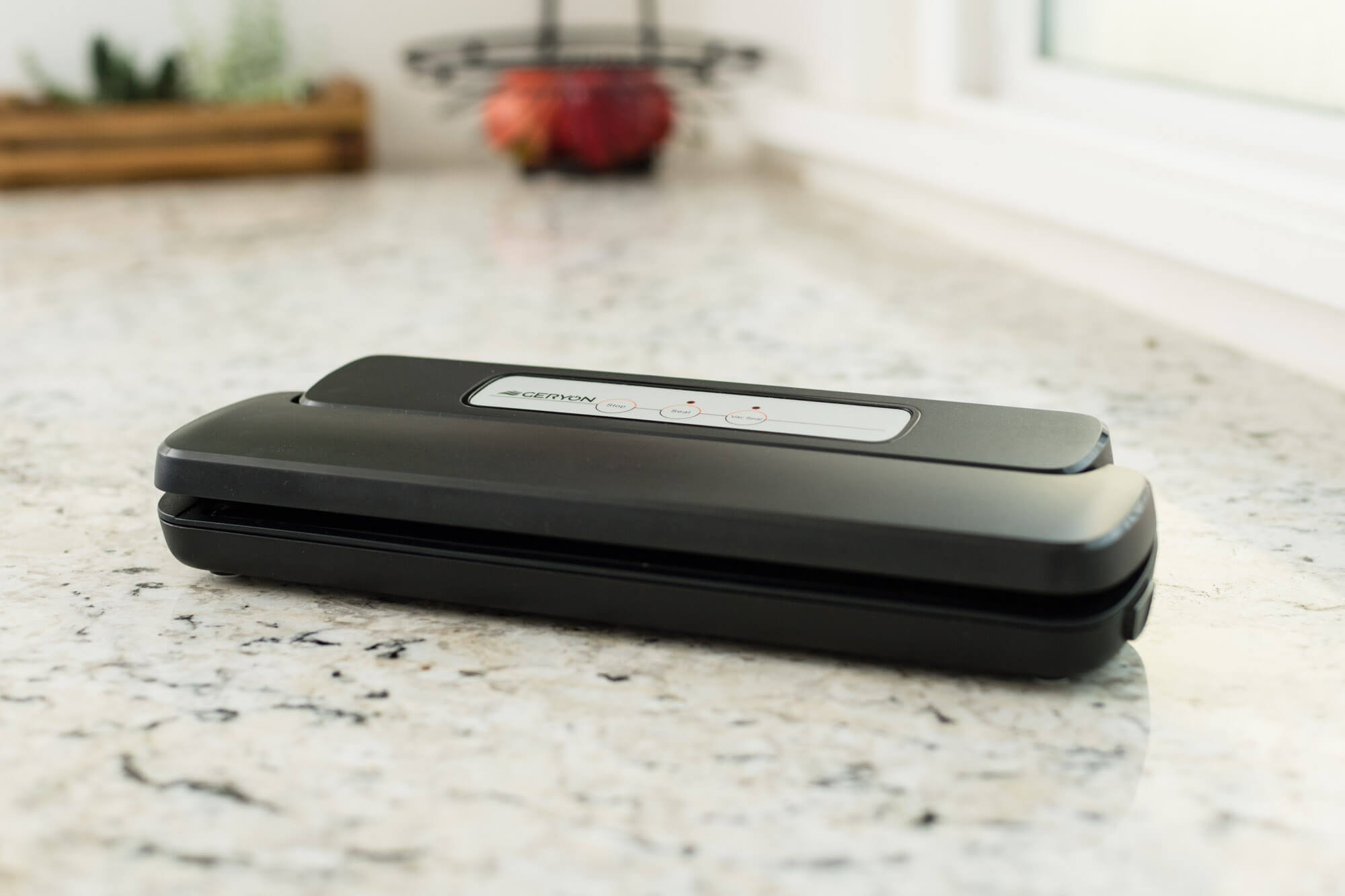
During our first round of testing the Geryon – E2800-C was nearly as good as our former top pick, the Tinvoo (now discontinued). It was fast, almost as powerful, and was even more compact.
It’s a great device for the home cook with little space in the kitchen, and it’s easy to transport and store in a cabinet. The Geryon’s stylish stainless-steel is attractive and can complement other appliances. The Geryon is also one of the quietest vacuum sealers that we tested.
For this 2021 update, we re-tested the Geryon and were less enthralled with its performance. It worked very well in vacuum-sealing a bag of dried kidney beans, creating an airless lock in about 14 seconds. We experimented with different sizes of bags and found that a bag had to be no smaller than seven inches to work properly.
The Geryon wasn’t as consistent with wet foods. It sealed the fish tightly, but the chicken breast was insufficiently sealed, and each bag had a small air pocket that would eventually create ice crystals inside. After several failed attempts — even after sufficient cooling of the unit — we gave up, opened up the sealed bags, and re-sealed the chicken with the Mueller. The Geryon was better, however, in sealing blanched broccoli and successfully vacuum-sealed the portion tightly.
Key takeaways:
- The Geryon’s compact size and attractive design is a good choice for small kitchens with limited counter space.
- It works best with dried food products and vegetables.
- The Geryon will seal wet foods after several tries and not always tightly.
3. Best w/Hand Pump: Foodsaver – v4840

The FoodSaver – v4840 almost wins by default because as its name implies, it has a built-in handheld pump. This is a nice addition if you want to seal very large objects with compatible zipper bags. It also doubles as storage for your sealing-bag roll and has a built-in slicer to cut custom-sized bags. This tried and true brand takes what’s good about the smaller FoodSaver – FM2000 and increases the power and improves the overall performance while adding plenty of additional features.
The size of the v4840 will pretty much assure it a permanent place on your kitchen counter. Having a bag roll storage and slicer built into the unit prevents your hunting around the kitchen for bags.
The FoodSaver was also the only one on our picks to feature an automatic start. To begin suction, you feed the end of the bag into the bottom tray and the unit will begin the process once it detects the bag. The unit also has instructions and tips printed inside the storage container which are definitely helpful. The key to getting it to work quickly is to orient the bag so that the curve of the bag faces down.
Key takeaways:
- The FoodSaver – v4840 is from a trusted and well-established brand that’s been manufacturing vacuum sealers for over 30 years.
- The automatic start makes for a convenient operation and gives this vacuum sealer a little more ease of use, especially when vacuum sealing multiple items in one session.
- Its large size accommodates bag roll storage, making this ideal if you have available counter space and don’t mind having a permanent place for it.
Who needs a vacuum sealer?
Food vacuum sealers are a great addition to the busy household looking to save time and money. They’re especially valuable for busy families who have memberships to bulk retailers like Costco and Sam’s Club. For anyone trying to save money and eliminate food waste, preservation is the key to success. Food sealers are great for extending shelf life, which will help keep foods preserved up to five times longer in both the refrigerator and the freezer, according to the FDA. A vacuum sealer not only lets you freeze raw food but leftovers as well.
Oxygen is the enemy of freshness and accelerates food spoilage. Vacuum sealers can extend shelf life by eliminating most of the oxygen in the bag. That said, it’s important to remember that food will eventually spoil over a long period of time, even if it’s been vacuum-sealed.
Important features to consider
Width of sealer: The size of the food you want to vacuum seal will determine what size bag you will need. Most food vacuum sealers are around 11 inches wide, which will accommodate most food items. Hunters will typically need a vacuum sealer at least 12 inches wide to vacuum seal larger portions of meat.
Speed/convenience/suction power: All of the vacuum sealers work exactly the same way, but each one will have different combinations of features for speed and convenience. Larger units will often include bag-roll storage and cutter — a great convenience — but one that comes with the cost of a larger unit. Other units will sacrifice vacuum control for a more powerful pump that reduces the time to remove oxygen, which can lead to crushing softer foods.
Versatility: If you also want to be able to seal jars and extra-large bags, a hose attachment is a great feature that will add versatility to your unit.
Noise: No food vacuum sealer is going to have an absolutely silent motor, but some are built with noise reduction in mind.
Size/weight: The importance of the size and weight will largely depend on the size of your kitchen. Assess your available counter space and your predicted frequency of use. Larger units will often have storage for bag rolls and come with a few other convenience features that offer a compelling reason to make permanent room on your counter. But if space is an issue, choose one of the lightweight vacuum sealers that’s easy to store.
Liquids/oily foods: It’s important for the vacuum sealer to be able to detect liquids and oils entering the vacuum chamber quickly and shut off the motor before they enter the main housing. Lower quality machines can break down quickly if they fail to shut off in time. Packaging will reflect whether or not this feature is present.
Warranty: With heavy use, even the best vacuum sealers may quit on you before you know it. Getting at least a one-year warranty will help ease your mind, should you use your vacuum sealer often.
Performance over long sessions: The average household won’t need to consider this often, but if you’re prepping for winter by sealing and storing in the freezer, it’s helpful to have a vacuum sealer that can maintain performance speed and quality over longer sessions. This is especially true for hunters that may need to seal large quantities of meat.
How long does vacuum-sealed food last?
Storage is everything when it comes to keeping your food fresh. Throughout more than 50 hours of testing vacuum sealers and discussing with food-safety experts, we also learned the length of time that popular food items last in the freezer, refrigerator, and pantry. Learn more about how long your food will last if vacuum sealed and stored properly with our guideline below.
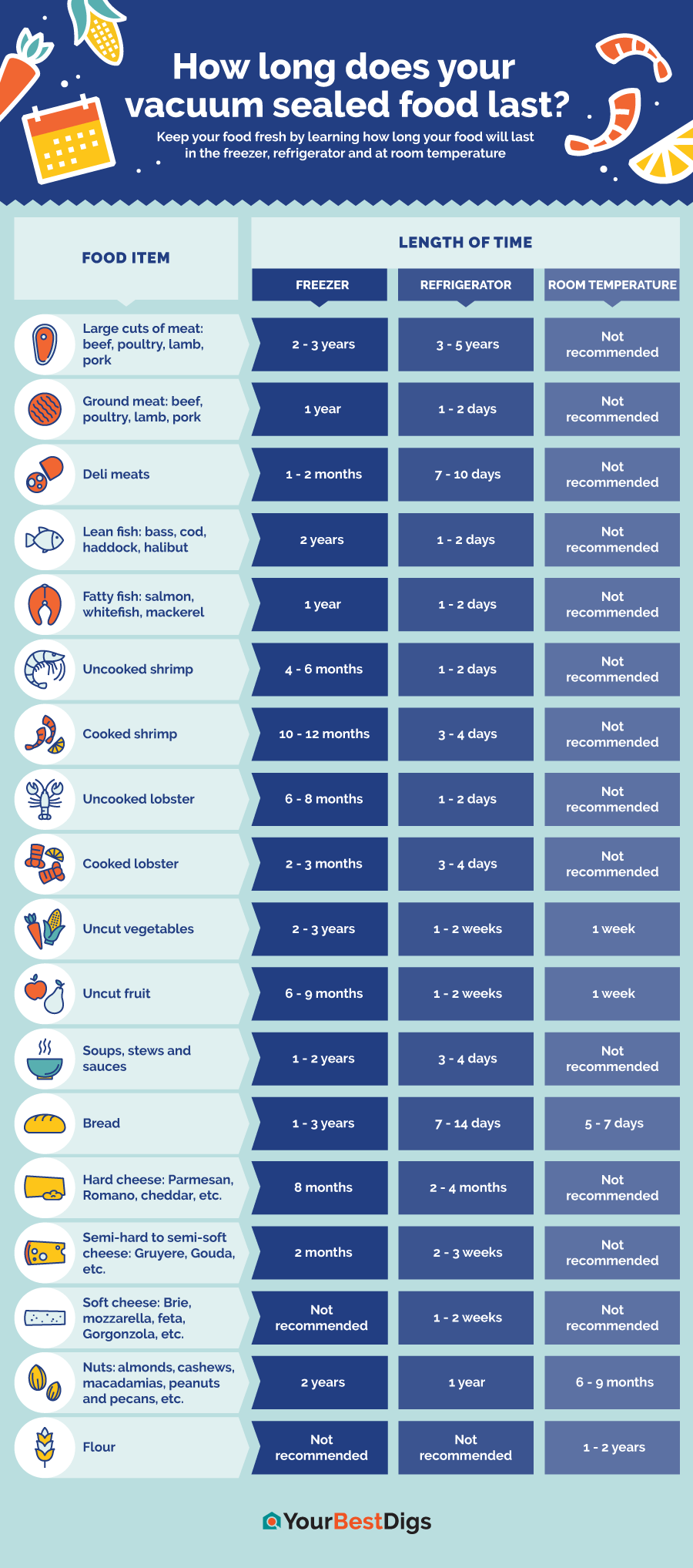
If you find yourself tossing expired food at the end of the week, investing in a vacuum sealer could save you money in the long run. Record how much food you’re throwing out without a vacuum sealer for a month — you might be surprised by how quickly it will pay for itself.
How we tested
Convenience
The first thing we wanted to know was how easy it was to get up and running with each of the vacuum sealers. Most of the units we tested were pretty straightforward: plug it into the wall, place food in the provided bag, place open end in the vacuum chamber, secure and press the vacuum button. The FoodSaver – V4840 was the only one that had an automated process, which took reading the directions beforehand to operate correctly. The directions are also on the machine itself and weren’t difficult to follow. The Geryon, NutriChef – Automatic Vacuum Air Sealer and Tinvoo – VS100S were the most intuitive and easiest to get started using.
The size and weight of the FoodSaver – V4840 made it the biggest vacuum sealer by far. It’s definitely meant to stay where you put it, so moving it around for storage will likely not be convenient. And while the Nesco – VS-02 was light in comparison, the dimensions were big enough to make it inconvenient to move around and store when not in use. The Geryon was by far the most portable food vacuum sealer.
Suction power

We looked at each vacuum sealer’s listed wattage and performed our own test to determine the suction power of each machine. We measured out six portions of six ounces of kidney beans, one portion for each sealer. We used the provided bags for each machine as they were all very similar in construction. We timed the process as well to further determine the convenience of each unit. To make the process as fair as possible, we eliminated as much air as possible by hand for each bag before beginning.
Speed comparison
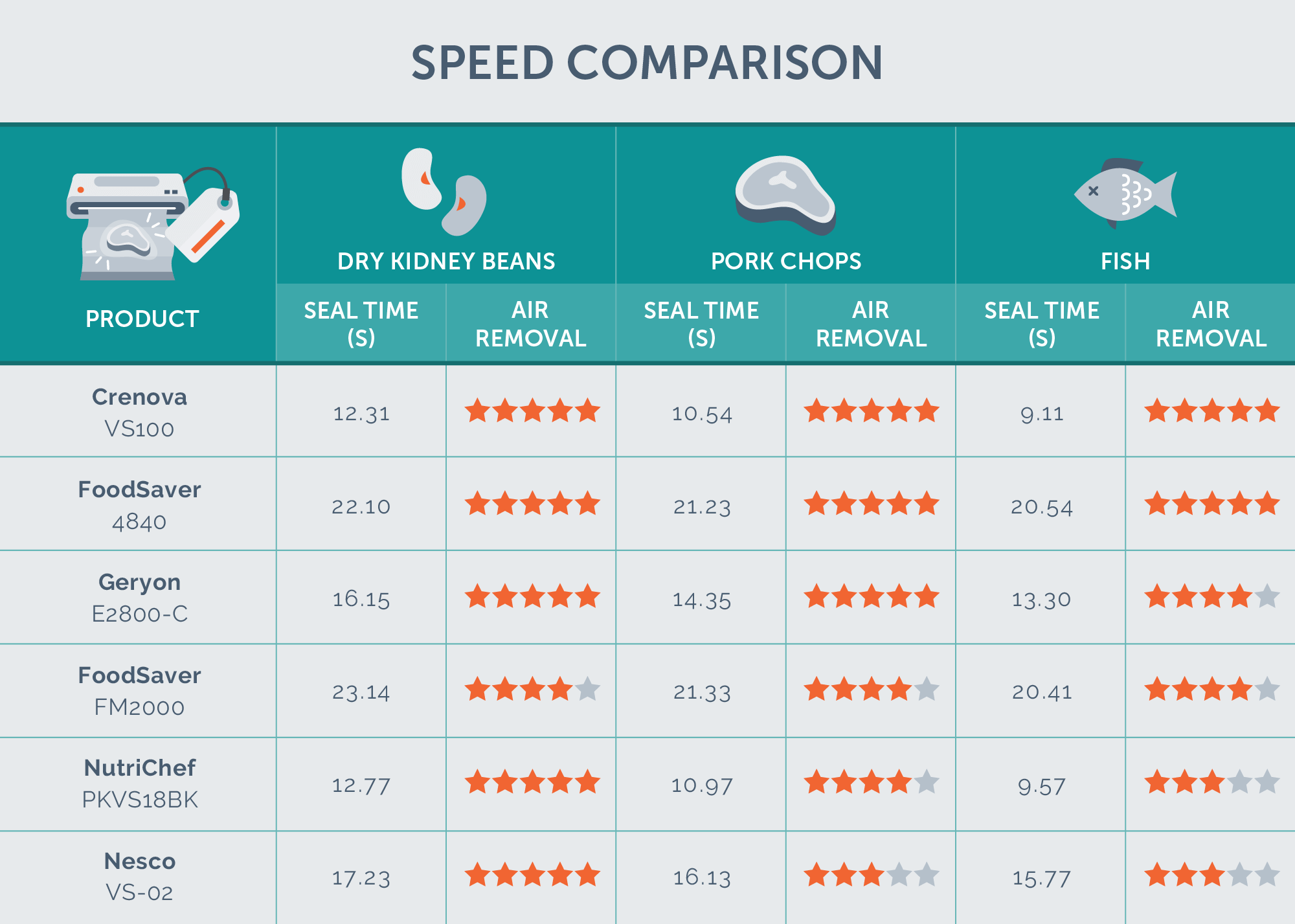
For our visual assessment, we looked closely to see how much air had been removed. The bags with the most air removed sealed most tightly to the beans. Vacuum sealing dry kidney beans is a pretty easy task for all six of our chosen vacuum sealers. The Tinvoo – VS100S had the quickest time and only the FoodSaver – FM2000 had a subpar vacuum seal with a time of almost ten seconds more than the best time recorded.
To further test our sealers on suction power and their ability to handle moisture-rich foods, we did another round of testing with pork chops and fish. The fish, being softer and more easily crushed to produce more moisture, was great for testing how good each unit was in shutting off before pulling too much moisture into the vacuum chamber.
How to get the most air removed from bags containing moisture-rich foods
Take a sheet or two of paper towels, and fold them horizontally until they are three-inches tall. Place the folded-up paper towel(s) in the top of the bag (make sure you still have plenty of room for the machine to seal without touching the towel(s)) and away from the food. The paper towel will soak up the moisture being pulled from the food, saving it from entering and damaging the vacuum sealer. It’s not recommended to use this method for sous vide cooking. The paper towel trick will collect residual moisture and remain in the top portion of the bag.
The Mueller, FoodSaver – V4840, and the NutriChef are the only vacuum sealers to have specific dry- and wet- food modes. In the case of the FoodSaver – V4840, this slowed down the process by removing more air before shutting off. The wet-food mode on the NutriChef had no discernible effect. We used it with the mode on and off with the same foods, and there was little difference in both time and results.
The moisture-rich fish helped further separate the quality of the suction achieved by each machine. The smaller units did very well. The Geryon and Tinvoo both shut off during appropriate times to ensure too much moisture didn’t enter the vacuum chamber. The Geryon barely edged out the FoodSave – FM2000 in our visual assessment of the pork chops, with a barely noticeable difference in the amount of air removed.
How to properly seal raw chicken
When vacuum sealing raw chicken, make sure to thoroughly clean the vacuum chamber after each use. Salmonella is always a risk factor when working with raw chicken in the kitchen. It’s important to clean the vacuum chamber after any liquid or juices from raw meat enter it to ensure food safety.
Performance
To test the performance of our six vacuum sealers we specifically wanted to look at longevity, the strength of the seal, and how well it would do with soft foods.
High volume testing
For our high volume test, we measured out 30 portions of kidney beans weighing six ounces each. We then vacuum sealed each one to see how many each unit could vacuum seal at 100% efficacy, meaning we did repeated vacuum sealing until each unit could no longer remove air to the same degree as the first bag sealed. We also checked to see how much rest each unit needed after failure before being able to use it again at 100% efficacy.
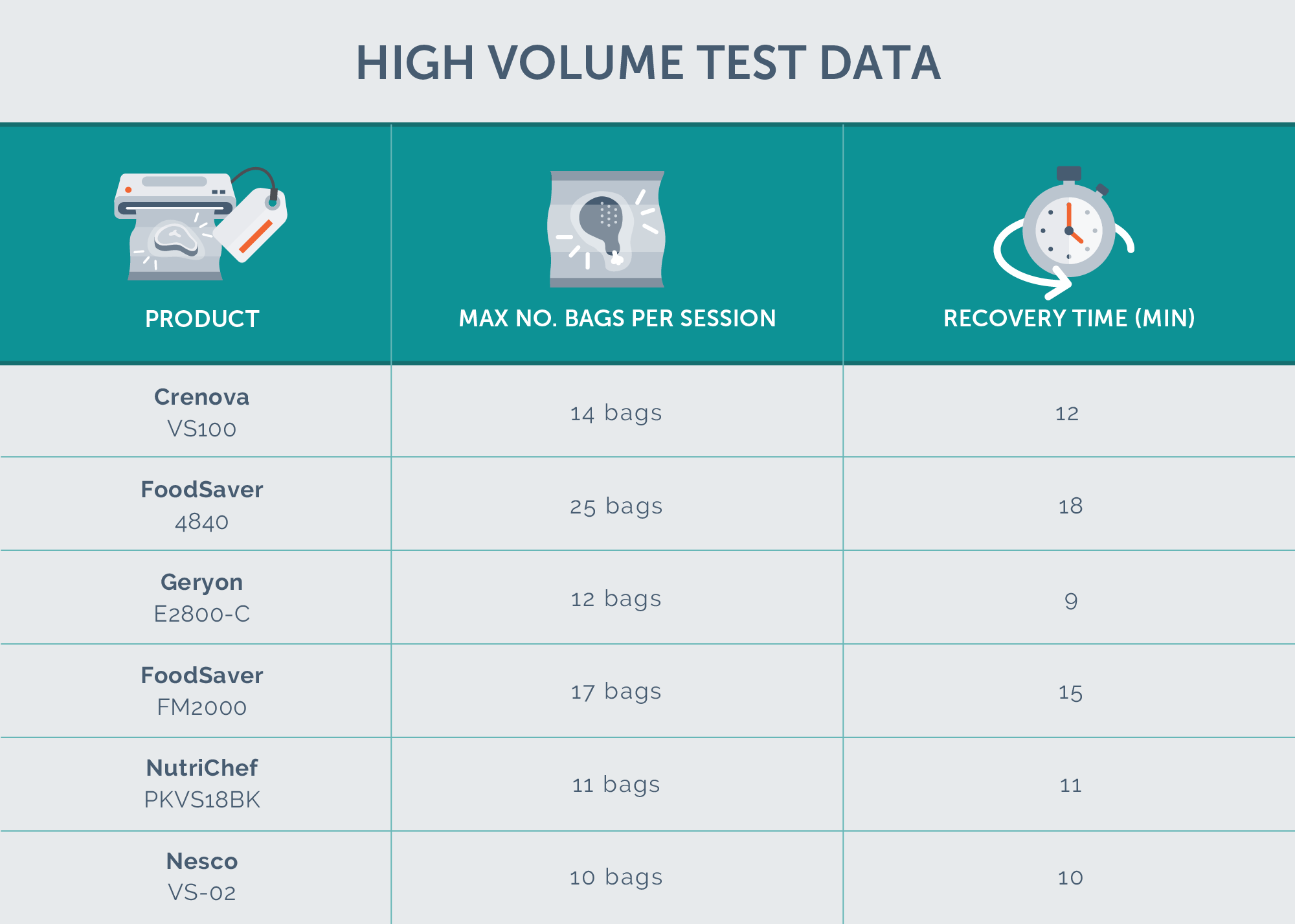
The FoodSaver – V4840 was a real champion at sealing bags consecutively. It made it to 25 bags before getting too hot to achieve a 100-percent vacuum on the next bag. The bags would start to seal from the heat, abd would not allow the machine to pull out air to create the vacuum. The cool-down time was also the longest, but we’ll forgive that due to the much higher bag count. We noticed that the units that were made of mostly plastic had quicker recovery times. The Nesco wasn’t able to last as long, but it cooled down and was able to get back to work faster than all, except the Geryon.
Strength of seal

We tested the strength of the seal through a variety of means, both normal and extreme. Our normal involved using a sous-vide cooking machine. Sous-vide cooking utilizes vacuum-sealed food to achieve a very thorough and even cooking that results in marvelously tasty meals. We used each unit to vacuum seal an eight-ounce portion of beef chuck for sous vide cooking.
Sous vide cooking takes an extremely long time compared to other methods, but is actually very easy and yields wonderful results. Our beef chuck was an excellent choice to use as it is a very inexpensive cut of beef that highlighted the benefits of using a sous-vide cooker.
We sealed each portion with seasoning, thyme, and rosemary before cooking. In this test, there was no clear winner as each performed admirably with equal results. Each portion was cooked perfectly throughout the entire portion.
For our first extreme test, we sealed six slices of apple and took these to the desert, leaving them in the sun while we rock climbed. This helped us check for oxidation, which helped us determine just how good the vacuum and the seal were. A pleasant surprise greeted us when we opened the bags; the apples were completely baked and tasted superb. The only bag to show signs of oxidation was the one we vacuum-sealed with the Nesco – VS-02, meaning it failed to achieve a high-level vacuum seal.
Our second extreme test involved sealing paper towels and taking them freediving with us to a depth of 60 feet. While it’s unlikely anyone will need to take vacuum-sealed food 60 feet underwater, we thought it would be a fun way to test how well the seal did under pressure. And not surprisingly, not a single bag leaked.
In the end, the only machine to underperform was the Nesco and only in terms of vacuum. Each unit performed admirably in regards to the strength of the seal.
Soft foods
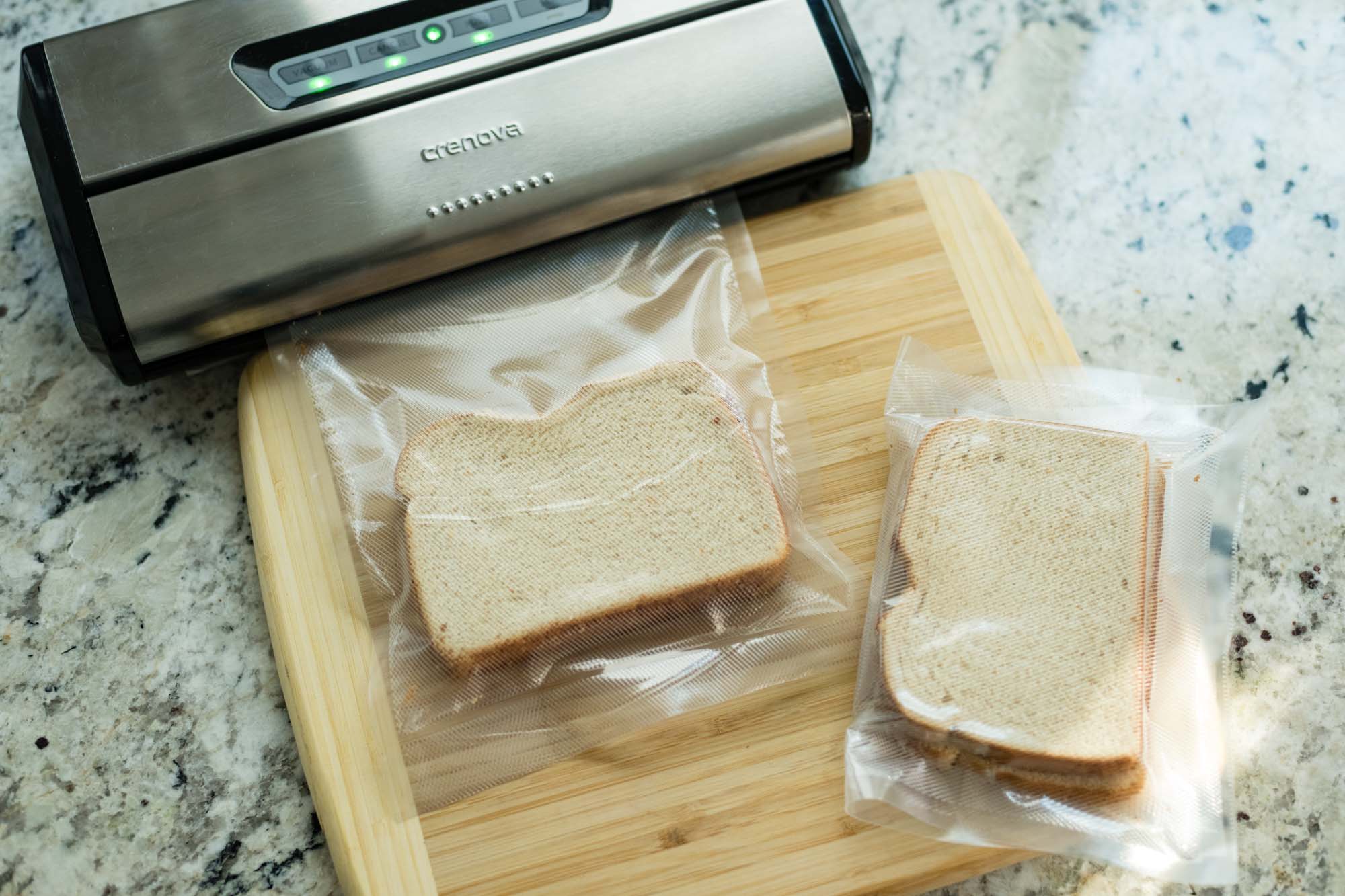
To check how well each food vacuum sealer dealt with vacuum sealing soft foods, we used the softest food we could think of: sliced bread. We placed two slices of bread into a bag, vacuum sealed it, and compared our results.
This allowed us to test how quickly the stop function worked on all the vacuum sealers. If you let any of them go automatically, they will each crush the bread into almost nothing. Every unit we tested stopped immediately after pressing the stop button, but the Nesco would allow a little bit of air to return to the chamber before sealing.
The Tinvoo – VS100S has a wonderful feature that allows you to remove a little more air in small bursts through a pulse button. This came in handy throughout our time with the unit.
Unique features
As mentioned above, the Tinvoo – VS100S has a pulse button that allows for quick bursts of suction to remove as much air as possible. This was especially useful for soft foods, but came in handy during other uses as well.
The FoodSaver – V4840 4840 and Nesco – VS-02 both come with storage for a bag roll. This is a fantastic feature that makes it easy to keep track of everything and create custom-sized bags. Both also have a slicer integrated into the machine to make cutting effortless and precise.
The FoodSaver – V4840 4840 is the only one we tested that came with an included canister pump that is attached to the machine. While this feature is not as commonly used, it’s a nice addition.
Cleaning
Keeping food vacuum sealers clean is essential. The rubber seal of the vacuum chamber is crucial to keeping them functioning properly, but it must also be regularly cleaned to be hygenic. In our testing, we found that all but the FoodSaver – V4840 4840 was easy to clean. The FoodSaver – V4840 4840 sliding tray made it difficult to thoroughly clean the device if too much liquid was pulled up during suction. However, the Geryon has a removable inner tray, making it the easiest to clean.
Other vacuum sealers we tested
Tinvoo – VS100S (Discontinued)
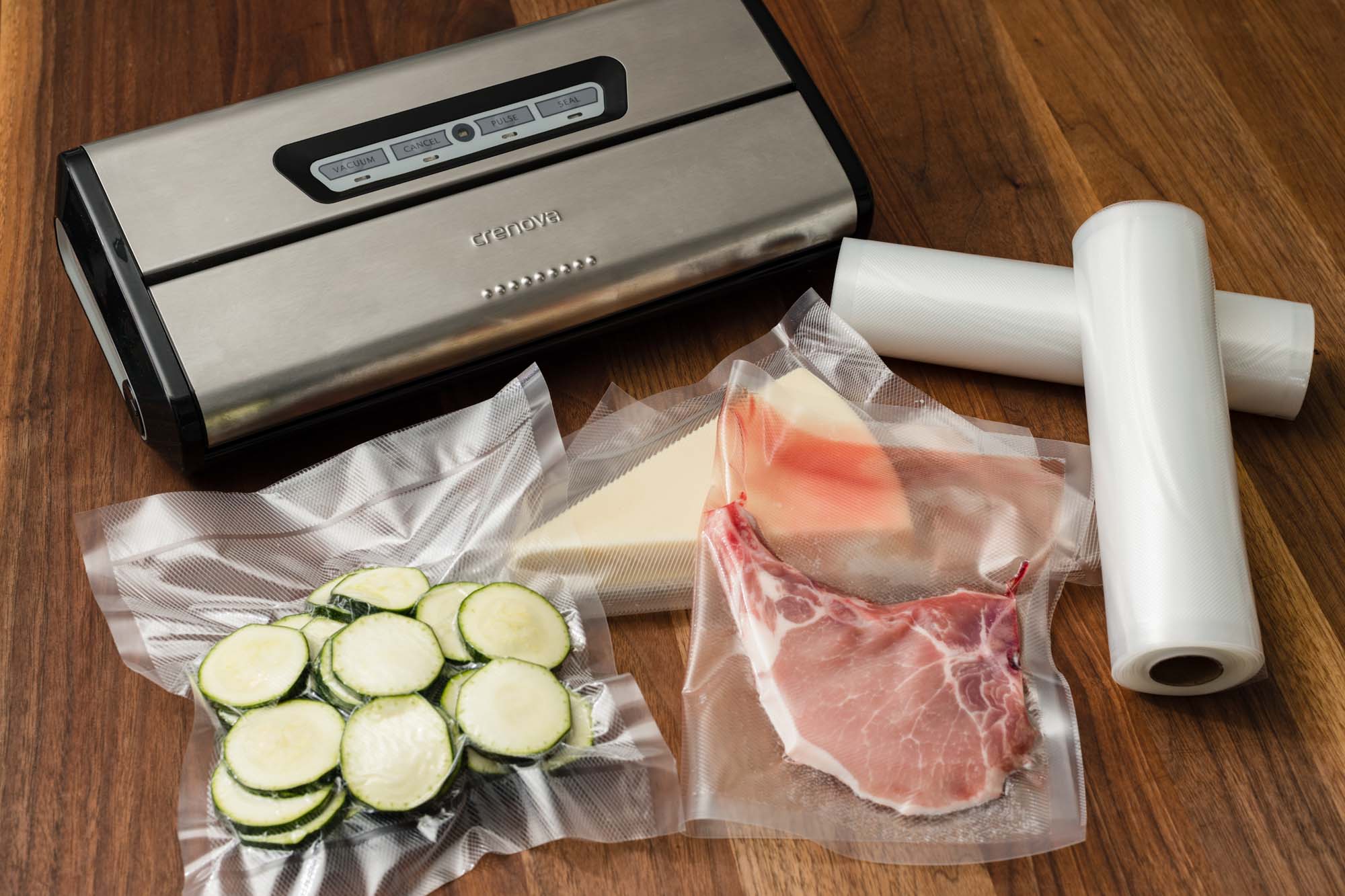
Of the six vacuum sealers we tested, the Tinvoo – VS100S stood out as the best. When used to vacuum seal pork chops and fish, it performed admirably and was easy to put away after sealing anything. While it isn’t the smallest unit, it’s relatively close in size to the Geryon — the smallest unit — and is still easily storable. The Tinvoo was also the quickest machine and was only outperformed in longevity by the two FoodSavers. This made our consecutive sealing test easier to perform in comparison to the other models. The simplicity of its design also lent it a nice aesthetic while in use in our kitchen.
We also appreciated how easy it was to use in comparison to the larger FoodSaver – V4840 4840 while still having similar features. The vacuum chamber was large, making it easy to place the open end of the bag into the machine. Pushing down on the machine to lock it into place took the least amount of guesswork due to the design. The Tinvoo hinge for the lid is very close to the front of the machine, giving it enough weight towards the back to balance the machine while pressing down the lid to lock.
The Tinvoo also featured a unique pulse function that allowed us to remove as much air as possible past the point of the machine’s automatic pump. This was extremely helpful when sealing moisture-rich foods with our paper-towel trick.
2020 update: We’ve gone through many rolls of vacuum-sealer bags with this unit and it’s still going strong. This unit has two latches, one on each side, that you need to ensure locks in before vacuum sealing. It’s easy to miss because the travel distance of the lid from lock to unlocked is very small, so occasionally we will try to vacuum seal but nothing happens. Luckily it doesn’t harm the bags, and it’s easily fixed by a quick press to lock the sides down.
FoodSaver – FM2000
Another entry from the most established brand in the market of food vacuum sealers, the Foodsaver – FM2000 unit worked well, offering a solid user experience while being much smaller than its bigger and more expensive older brother. Even though it was the loudest of the bunch we tested, it was still relatively quiet.
It doesn’t beat out our favorites, but it still performs admirably and has been well-received by daily users for years. It’s a fan favorite and is often found in the kitchens of those who love sous vide cooking.
The FM2000 finished second, after it’s bigger sibling, in how long it could be used continuously. So if you’re a hunter that will be needing longer sessions or someone who does winter storing in bulk, this is a great alternative to the very expensive commercial-grade vacuum sealers.
NutriChef – PKVS18BK
Another small and lightweight unit, the NutriChef – PKVS18BK put up very respectable numbers in all our tests. It had one of the most aesthetically pleasing designs of the bunch and would fit well in a modern-style kitchen.
The touchscreen-style buttons were a neat touch that made the device feel far more futuristic than the other units, giving it an air of sophistication. Its small size and performance make it a great all rounder as it had a satisfying locking mechanism when we used it. This made multiple sessions easy and never left us double-checking to ensure both sides were secure before sealing.
Nesco – VS-02
The Nesco – VS-02 was the only other unit we tested to feature a built-in storage for bag rolls along with a slicer to help make precise cuts. Its larger size will be more at home as a permanent resident on your countertop, but it’s light enough to be portable as well should you want to keep it in the pantry.
For those that are new to vacuum sealing their food, this is a great start to see if you’re going to be spending the time to seal and store. It won’t break the bank and it will meet all the needs of the occasional sealer.
The bottom line
When it comes to saving time and money in the kitchen, eliminating food waste is a crucial component to success. The best way to eliminate food waste is to extend shelf life, and a vacuum sealer is the best method for to so. The Mueller – MFFS-01 comes in as our top choice for its ability to quickly and powerfully vacuum seal dry and wet food, and its compact and portable size makes it great for small kitchens. Our runner-up is the Geryon – E2800-C, and although it’s not as consistent as the Mueller, it’s still a great choice if you have minimal counter space. The FoodSaver – V4840 is a larger, more expensive unit, but its built-in hand pump and sealer bag storage and cutter make it a versatile vacuum sealer.
More Reviews
Char-Broil - Performance
The 9 Best Microwave Bacon Cookers
Presto - Power Crisp
Instant Pot - DUO60
Cuisinart - MSC-600
Masterbuilt - 20071117
LEM Products - 1152
Chef’sChoice - 1520


